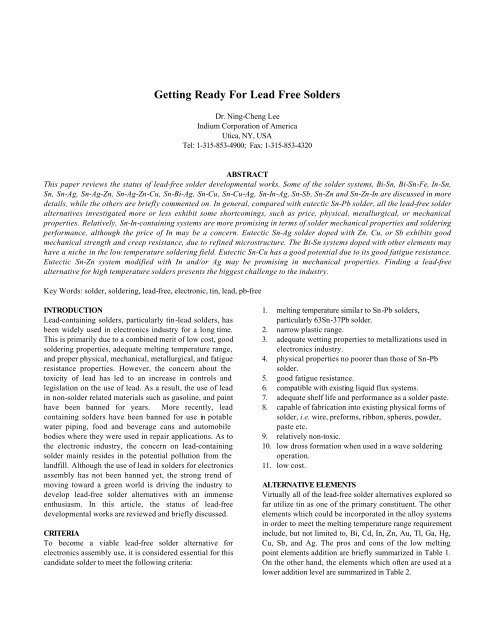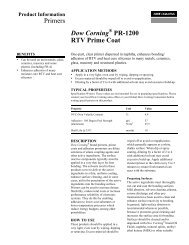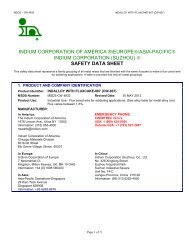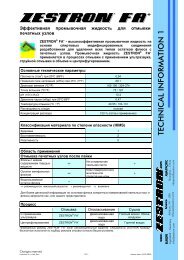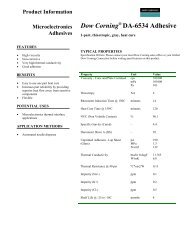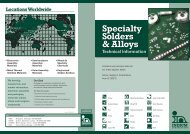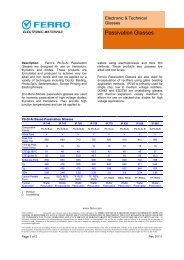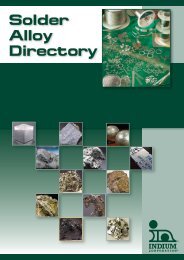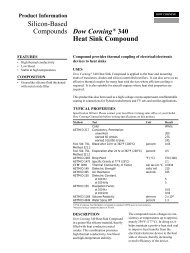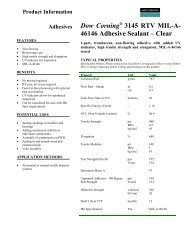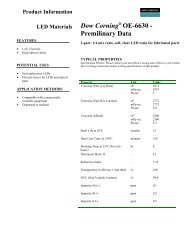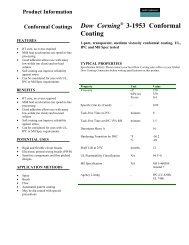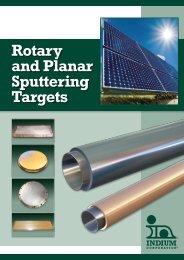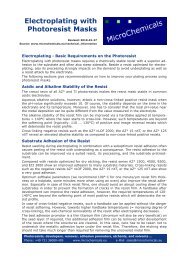Getting Ready for Lead Free Solders
Getting Ready for Lead Free Solders
Getting Ready for Lead Free Solders
You also want an ePaper? Increase the reach of your titles
YUMPU automatically turns print PDFs into web optimized ePapers that Google loves.
<strong>Getting</strong> <strong>Ready</strong> For <strong>Lead</strong> <strong>Free</strong> <strong>Solders</strong>Dr. Ning-Cheng LeeIndium Corporation of AmericaUtica, NY, USATel: 1-315-853-4900; Fax: 1-315-853-4320ABSTRACTThis paper reviews the status of lead-free solder developmental works. Some of the solder systems, Bi-Sn, Bi-Sn-Fe, In-Sn,Sn, Sn-Ag, Sn-Ag-Zn, Sn-Ag-Zn-Cu, Sn-Bi-Ag, Sn-Cu, Sn-Cu-Ag, Sn-In-Ag, Sn-Sb, Sn-Zn and Sn-Zn-In are discussed in moredetails, while the others are briefly commented on. In general, compared with eutectic Sn-Pb solder, all the lead-free solderalternatives investigated more or less exhibit some shortcomings, such as price, physical, metallurgical, or mechanicalproperties. Relatively, Sn-In-containing systems are more promising in terms of solder mechanical properties and solderingper<strong>for</strong>mance, although the price of In may be a concern. Eutectic Sn-Ag solder doped with Zn, Cu, or Sb exhibits goodmechanical strength and creep resistance, due to refined microstructure. The Bi-Sn systems doped with other elements mayhave a niche in the low temperature soldering field. Eutectic Sn-Cu has a good potential due to its good fatigue resistance.Eutectic Sn-Zn system modified with In and/or Ag may be promising in mechanical properties. Finding a lead-freealternative <strong>for</strong> high temperature solders presents the biggest challenge to the industry.Key Words: solder, soldering, lead-free, electronic, tin, lead, pb-freeINTRODUCTION<strong>Lead</strong>-containing solders, particularly tin-lead solders, hasbeen widely used in electronics industry <strong>for</strong> a long time.This is primarily due to a combined merit of low cost, goodsoldering properties, adequate melting temperature range,and proper physical, mechanical, metallurgical, and fatigueresistance properties. However, the concern about thetoxicity of lead has led to an increase in controls andlegislation on the use of lead. As a result, the use of leadin non-solder related materials such as gasoline, and painthave been banned <strong>for</strong> years. More recently, leadcontaining solders have been banned <strong>for</strong> use in potablewater piping, food and beverage cans and automobilebodies where they were used in repair applications. As tothe electronic industry, the concern on lead-containingsolder mainly resides in the potential pollution from thelandfill. Although the use of lead in solders <strong>for</strong> electronicsassembly has not been banned yet, the strong trend ofmoving toward a green world is driving the industry todevelop lead-free solder alternatives with an immenseenthusiasm. In this article, the status of lead-freedevelopmental works are reviewed and briefly discussed.CRITERIATo become a viable lead-free solder alternative <strong>for</strong>electronics assembly use, it is considered essential <strong>for</strong> thiscandidate solder to meet the following criteria:1. melting temperature similar to Sn-Pb solders,particularly 63Sn-37Pb solder.2. narrow plastic range.3. adequate wetting properties to metallizations used inelectronics industry.4. physical properties no poorer than those of Sn-Pbsolder.5. good fatigue resistance.6. compatible with existing liquid flux systems.7. adequate shelf life and per<strong>for</strong>mance as a solder paste.8. capable of fabrication into existing physical <strong>for</strong>ms ofsolder, i.e. wire, pre<strong>for</strong>ms, ribbon, spheres, powder,paste etc.9. relatively non-toxic.10. low dross <strong>for</strong>mation when used in a wave solderingoperation.11. low cost.ALTERNATIVE ELEMENTSVirtually all of the lead-free solder alternatives explored sofar utilize tin as one of the primary constituent. The otherelements which could be incorporated in the alloy systemsin order to meet the melting temperature range requirementinclude, but not limited to, Bi, Cd, In, Zn, Au, Tl, Ga, Hg,Cu, Sb, and Ag. The pros and cons of the low meltingpoint elements addition are briefly summarized in Table 1.On the other hand, the elements which often are used at alower addition level are summarized in Table 2.
Table 1. Low melting point elements as alloy addition to tin.ElementPossible wt Solidus Liquidusaddition (%) range (°C) range (°C)Toxicity Cost AvailabilityBi 0-100 138 138-270 No Acceptable ModerateCd 0-100 188 177-320 High Acceptable ModerateIn 0-100 117-150 117-232 No Medium LowZn 0-90 198 198-400 No Low GoodAu 0-82 218-310 218-400 No V. high LowTl 0-100 165 165-300 V. high ? LowGa 0-100 18 18-232 No High LowHg 0-100 140 -40-+232 V. high High LowTable 2. Lower level alloying addition to tin.ElementPossible wt Solidus Liquidusaddition (%) range (°C) range (°C)Toxicity Cost AvailabilityAg 10 221 221-300 No High ModerateCu 3 227 227-320 No Low HighSb 5 232-236 236-240 No Moderate AdequateThe lead content is 13 ppm in Earth’s crust; and is 0.003ppm in seawater. This ample supply results in a very lowcost of lead. There<strong>for</strong>e, chance is that any lower toxicitysubstitute metals <strong>for</strong> lead in solder will be more expensivethan lead. It is estimated that 4500 metric tons of lead areconsumed per year in the U.S. to manufacture electronicsolder. The world wide consumption is about three timesof this figure. This volume is quite significant.Consequently, in order to replace lead, the present andfuture availability of any substitute material should also beexamined carefully.The supply status of some potential candidate elements<strong>for</strong> lead-free solder alternatives is shown in Table 3. Itappears that the current supply of Ga and In is less thanthe demand as a direct lead replacement option. Thissuggests that an increase in both capacity and productionscale is required in order to allow those elements tobecome a direct overall lead replacement in solders. As tothe rest elements, the world spare capacity is high enoughto allow a reasonably short transition period <strong>for</strong> the lead tobe phased out. In the case of Ag and Bi, some ef<strong>for</strong>t onthe expansion of world production scale and worldcapacity may be needed if either one ends up as theprimary substitute choice of industry.ALTERNATIVE SOLDER ALLOYS INVESTIGATEDRECENTLYTable 3. Supply status of potential candidate elements <strong>for</strong> lead-free solder applicationsWorld production World capacity Spare capacityElement(tons)(tons)(tons)Ag 13,500 15,000 1,500Bi 4,000 8,000 4,000Cu 8,000,000 10,200,000 2,200,000Ga 30 80 50In 120 > 240 120Sb 78,200 122,300 44,100Sn 160,000 241,000 81,000Zn 6,900,000 7,600,000 700,000
Table 4. <strong>Lead</strong>-free solder alloys investigated recently.AlloycategoryCompositionSolidus(°C)Liquidus(°C)NoteDensityManufacturer orinvestigatorSn-Pb 63Sn-37Pb 183 183 Eutectic 8.40 (Control)Au-Sn 80Au-20Sn 280 280 Eutectic 14.51Bi-Cd 60Bi-40Cd 144 144 Eutectic 9.31 IndiumBi-In 67Bi-33In 109 109 Eutectic 8.81 IndiumBi-In-Sn 57Bi-26In-17Sn 79 79 EutecticBi-Sn 58Bi-42Sn 138 138 Eutectic 8.5695Bi-5Sn 134 251 9.64 IndiumBi-Sn-Fe 54.5Bi-43Sn-2.5Fe 137 AT&TBi-Sn-In 56Bi-42Sn-2In 138 IBMBi-Sb 95Bi-5Sb ~275 ~308 FordIn-Ag 97In-3Ag 143 143 Eutectic 7.38 Indium90In-10Ag 141 237 7.54 IndiumIn-Bi-Sn 48.8In-31.6Bi-19.6Sn 59 59 Eutectic?51.0In-32.5Bi-16.5Sn 60 60 Eutectic 7.88 IndiumIn-Sn 60In-40Sn 118 ~12752In-48Sn 118 118 Eutectic 7.30 Indium50In-50Sn 118 125 7.30 IndiumSn 100Sn 232 232 7.28 IndiumSn-Ag 96.5Sn-3.5Ag 221 221 Eutectic 7.36 Indium95Sn-5Ag 221 ~250Sn-Ag-Cu 93.6Sn-4.7Ag-1.7Cu 216 216 Eutectic Iowa State USn-Ag-Cu-Sb 96.2Sn-2.5Ag-0.8Cu-0.5Sb 210 217 AIM (CASTIN)Sn-Ag-Sb 65Sn-25Ag-10Sb 233 MotorolaSn-Ag-Zn 95.5Sn-3.5Ag-1.0Zn 217 AT&TSn-Ag-Zn-Cu 95Sn-3.5Ag-1.0Zn-0.5Cu AT&TSn-Bi-Ag 91.8Sn-4.8Bi-3.4Ag 211 SandiaSn-Bi-Ag-Cu 91.0Sn-4.5Bi-3.5Ag-1.0Cu 210 SenjuSn-Bi-Cu-Ag 48Sn-46Bi-4Cu-2Ag IBMSn-Bi-Cu-Ag-PBi 0.08-20%, Cu 0.02-1.5, Ag0.01-1.5, P 0-0.20, rare earthmixture 0-0.20. balance SnCooksonSn-Cd 67.8Sn-32.2Cd 177 177 Eutectic 7.68 IndiumSn-Cu 99.3Sn-0.7Cu 227 22799Sn-1Cu 227 227 Eutectic97Sn-3Cu 227 ~330 FordSn-Cu-Ag 95.5Sn-4Cu-0.5Ag 225 349 (260) Engelhard (Silvabrite 100)Sn-Cu-Sb-Ag 95.5Sn-3Cu-1Sb-0.5Ag 256 MotorolaSn-In 70Sn-30In 120 ~17558Sn-42In 118 145 7.30 IndiumSn-In-Ag 77.2Sn-20.0In-2.8Ag 175 187 7.25 IndiumSn-In-Ag-Sb 88.5Sn-10.0In-1.0Ag-0.5Sb 211 QualitekSn-In-Bi 90Sn-8In-2Bi IBM80Sn-10In-10Bi 153 199 IBMSn-In-Bi-Ag 78.4Sn-9.8In-9.8Bi-2Ag80Sn-10In-9.5Bi-0.5Ag 179 201 FordSn-Sb 95Sn-5Sb ~234 240 MotorolaSn-Sb-Bi-Ag Sn approx 90-95%. Sb 3-5%,Willard IndustriesBi 1-4.5, Ag 0.1-0.5Sn-Zn 91Sn-9Zn 199 199 Eutectic 7.27 IndiumSn-Zn-In 87Sn-8Zn-5In 175 188 AT&TSn-Zn-In-Ag 87Sn-8Zn-5In-0.1Ag AT&TSn-Zn-In-Cu 87Sn-8Zn-5In-0.1Cu AT&T
The lead-free solder alloys investigated recently arecompiled in Table 4. Also shown are the meltingtemperature and density of those alloys, whenever theyare available. In<strong>for</strong>mation shown here provides a profileabout current ef<strong>for</strong>t of industry. Most of the systemsinvestigated aim at electronic applications. A quick glanceat this table confirms that Sn is indeed the primary choiceas one of the alloy component.PROPERTIES OF SOME ALLOY SYSTEMSSome eutectic alloy systems, such as Bi-Sn, In-Sn, Sn-Ag,Sn-Cu, and Sn-Zn, have been studied very extensively inthe past already. Some other systems such as Sn-Bi-Ag,Sn-In-Ag, Sn-Sb, or Sn-Zn-In systems or the eutecticalloys described above doped with other elements areinvestigated due to their promising mechanical strengthand creep resistance. The results of those investigationare briefly summarized below.58Bi-42Sn58Bi-42Sn is relatively inexpensive and has a proven trackrecord at IBM ® where it has been used in wave solderingof printed circuit assemblies. However the melting point islower than tin/lead eutectic. Compared with Sn63, thewetting of eutectic Sn-Bi is not as good, but acceptable.This is true <strong>for</strong> both bare copper and Ni-Au platedsubstrate. Au dissolves more slowly into molten eutectic58Bi-42Sn solder than into eutectic Sn-Pb. This maycontribute to a reduction in the wetting ability and the<strong>for</strong>mation of intermetallics as well. In general, conventionalsolders, when Sn is replaced with Bi, are less prone tointermetallics <strong>for</strong>mation. Although the wetting of 58Bi-42Sn seems to be acceptable, the allowed concentration of<strong>for</strong>eign elements is an order of magnitude lower <strong>for</strong>eutectic 58Bi-42Sn than <strong>for</strong> eutectic Sn-Pb solder.There<strong>for</strong>e, presence of 0.0002% Phosphorus would causewetting to degrade. This suggests a potential problem onelectroless Ni which usually contains some Phosphorus.At Sn-Bi soldering operation where Sn-Pb platedcomponents got into the mixture, the 8Sn-52Pb-40Bieutectic mixture (mp 95°C) <strong>for</strong>med and became moltenduring -40 to100°C thermal cycling. Very early failure andextensive porosity is observed, probably a result of localmelting during cycling. The shear strength and life increep rupture tests at 50-80°C decreased relative to jointsmade on plain Cu.When the alloy has an equiaxed grain structure, it can bequite ductile and may exhibit superplastic behavior. WhenSn63 solder has an equiaxed microstructure, its fatigue lifeis improved vs a lamellar microstructure. The advantage ofSn63 over 58Bi-42Sn is that an equiaxed microstructure isachievable <strong>for</strong> Sn63 at typical cooling rates, which seemsnot to be the case <strong>for</strong> 58Bi-42Sn . At 100°C, Sn63 is farsuperior to 58Bi-42Sn , presumably because 100°C is sucha high homologous temperature (0.91) <strong>for</strong> 58Bi-42Sn.The Utimate Tensile Strength (UTS) data <strong>for</strong> eutectic Sn-Bi(54-73 MNm-2) are slightly higher than Sn63 (19-56 MNm-2). Between 20 and 60°C, shear strength of eutectic Sn-Bi(25-50 MNm-2) are comparable to eutectic Sn-Pb. At 100C,eutectic Sn-Bi is much weaker than eutectic Sn-Pb.Elongation of eutectic Sn-Bi is more sensitive thaneutectic Sn-Pb (i.e. its elongation decreases more rapidlywith increasing strain rate).54.5Bi-43Sn-2.5Fe (Bi-Sn with Fe dispersoid particles)Mechanical properties of solders can benefit from uni<strong>for</strong>mdispersion of fine precipitates and small effective grainsizes. There<strong>for</strong>e, magnetically distributed insoluble Feparticles retard both high-temperature de<strong>for</strong>mation andmicrostructural coarsening, thus widening the usefulservice range of Bi-Sn eutectic alloys to much higherhomologous temperature than are typical <strong>for</strong> Sn63. Inaddition, the presence of a magnetically dispersed threedimensionalnetwork of finely dispersed iron particles in aBi-43Sn eutectic solder under the same high temperatureconditions resulted in a 5X increase in creep resistance at100°C. Combination of high mechanical strength and highductility is likely to yield improved fatigue resistanceproperties in the interconnection. Elements other than Fecan also be used to create fine precipitates. Hence,addition of 1% Cu dramatically slows coarsening ofeutectic Sn-Bi, presumably via similar mechanism.52In-48Sn52In-48Sn is considered the lowest melting point practicalsolder. It is often used as the last step in a sequentialsoldering operation, and <strong>for</strong> soldering to metallizations ontemperature sensitive components. Less than 1%Au issoluble in eutectic 52In-48Sn at 50°K above liquidustemperature. The intermetallic AuIn 2 resulted is aneffective diffusion barrier to In, Sn, and Au, henceprevents further dissolution of Au plating. Eutectic 52In-48Sn displays fair to acceptable wetting behavior, but onlywith a relatively active flux. Wetting on Cu, Ni-Sn, andpretinned Kovar (53Fe-17Co-29Ni) can be acceptable at215°C, but wetting on Au is sluggish and poor.For a specified creep life, the load was approximately onequarter of the load <strong>for</strong> eutectic Sn-Pb. Creep behavior of52In-48Sn is characterized by rapid and extensivede<strong>for</strong>mation leading to early failure. There is nomicrostructural change like coarsening & recrystallisationthat occur in Sn63. This stability is due to rapid recoveryof de<strong>for</strong>mation. The isothermal fatigue behavior and
fatigue life in temperature cycling test of 52In-48Sn arepoorer than that of eutectic Sn-Pb. Compared with high Snalloys, In alloys is slow in crack propagation. Thisbehavior may contribute to the better fatigue per<strong>for</strong>manceof In alloys at low cyclic strain rates versus that of high Snalloys.Between 20 and 60°C, shear strength of eutectic 52In-48Snis much weaker than eutectic Sn-Pb. Rapid drop in shearstrength <strong>for</strong> 52In-48Sn reflect the fact that the homologoustemperature at which the testing was done is much higher<strong>for</strong> eutectic Sn-In (mp 121°C) than <strong>for</strong> Sn63 (mp 183°C). For52In-48Sn, the shear strength on Ni is almost 50% lowerthan <strong>for</strong> samples on Cu. This may be due to the dissolvedCu into In-Sn, which takes the alloy away from eutecticcomposition and may harden it as well.52In-48Sn is relatively ductile. Elongation is reported to be83% (vs 32% <strong>for</strong> Sn63) and 36% (vs 22.5% <strong>for</strong> Sn63). Thishigher elongation is a result of superplastic behavior increep under shear loading at temperature above 0.8 of theirmp. The superplastic microstructure generally has a longerisothermal fatigue life than non-superplastic. Pb-Sn <strong>for</strong>meda recrystallized band of material along a region ofconcentrated shear de<strong>for</strong>mation. This microstructuralchanges did not occur in the 52In-48Sn samples.SnTin is mostly consumed by the electronics industry, whichuses 60,000 tonnes/yr. Replacing toxic Pb in solders withnontoxic Sn could increase consumption in electronicssolders by one third. Compared with Sn63, the wetting ofSn on Cu is superior. Feasibility <strong>for</strong> eliminating tin leadplating of electronic components by tin plating could beacceptable in many applications where device would notbe subjected to sub-zero temperature or where whiskergrowth would not present problems. Sandia National Labconsiders that 100Sn is a viable candidate as a substitute<strong>for</strong> 60Sn-40Pb.96.5Sn-3.5AgAu dissolves more rapidly into Sn than into eutectic Sn-Pbsolder <strong>for</strong> the same amount of superheating. The same istrue <strong>for</strong> eutectic 96.5Sn-3.5Ag, but it is more tolerant of Authan eutectic Sn-Pb. 96.5Sn-3.5Ag containing 5% Au isductile and the elongation deteriorated only very little, dueto much smaller AuSn 4 IMC grain size. On the other hand,Sn63 containing 5% Au is brittle and the elongationdecreased dramatically.Compared with Sn63, the wetting of 96.5Sn-3.5Ag is quitepoor. Wetting of 96.5Sn-3.5Ag did not improvesignificantly in inert atmosphere, perhaps because Ag isnot readily oxidized. The poor wettability of 96.5Sn-3.5Agis caused by high interfacial tension between solder andflux that is probably related to the high surface tension ofAg.The UTS data <strong>for</strong> 96.5Sn-3.5Ag (20-56 MNm -2 ) arecomparable with or slightly higher than Sn63 (19-56 MNm -2 ) (and slightly lower than eutectic Sn-Bi (54-73 MNm -2 )).Between 20 and 60°C, shear strength of eutectic Sn-Ag(25-50 MNm -2 ) are comparable to eutectic Sn-Pb. Eutectic96.5Sn-3.5Ag has comparable elongation to Sn-Pb atmoderate strain rates at R.T., but is probably less strainrate sensitive (i.e. its elongation does not rise as rapidly atslow strain rates). At strain rate of 6.2 x10 -4 s -1 , strainhardening and softening rates of Sn63 is much faster than96.5Sn-3.5Ag.Creep resistance in descending order was: Sn62 > 96.5Sn-3.5Ag > Sn63 > 58Bi-42Sn > 60Sn-40Pb > 70Sn-30In > 60In-40Sn. 96.5Sn-3.5Ag absorbed considerably more strainbe<strong>for</strong>e failure than Sn63. The acceleration factor in athermal cycling test vs field service will be greater <strong>for</strong>96.5Sn-3.5Ag than <strong>for</strong> Sn63. 96.5Sn-3.5Ag has far superiorR.T. isothermal fatigue behavior to Sn63 at high shearstrain amplitudes (due to the resistance of 96.5Sn-3.5Ag tofatigue crack initiation), but is far inferior to Sn63 at lowstrain amplitudes. For 95Sn-5Ag, no microstructurecoarsening occurred. Only the IMC layer thicknessincreased. Cracks propagated at the solder/intermetallicinterface and through the solder. However, no completefailures were observed after 70 cycles.96.5Sn-3.5Ag eutectic solder has superior overall propertyand is suitable <strong>for</strong> solder interconnects in thick filmautomotive electronics packages when used with a mixedbonded Ag conductor.95.5Sn-3.5Ag-1Zn95.5Sn-3.5Ag-1Zn (mp 217C) can significantly improvemechanical strength of 96.5Sn-3.5Ag by as much as 48%while maintaining the same level of ductility. The hightemperature creep resistance of Zn-containing alloyimproved more than an order of magnitude. Strengtheningis attributed to a substantial refinement of precipitates inthe solidification microstructure. It also significantlyimproved creep resistance. Zn is incorporated in the morecorrosion resistant Ag 3 Sn precipitates, leaving Sn-richmatrix primarily free of Zn in solid solution. It refines themicrostructure and suppresses <strong>for</strong>mation of Sn dendriteswhile making Ag 3 Sn precipitates finer & more spherical.Zn also suppresses mp slightly. The continuous Sn phasemay be prone to whisker and tin pest.95Sn-3.5Ag-1Zn-0.5Cu
Addition of small amount (1% is not desirable as itcauses precipitates of additional IMC phases that depletethe finely dispersed precipitates in the surrounding matrixand induces non-uni<strong>for</strong>mities in microstructure thatconsequently deteriorates the mechanical properties.91.8Sn-4.8Bi-3.4AgSandia Lab has developed 91.8Sn-4.8Bi-3.4Ag withliquidus temperature 211°C. In the study of AT&T, thisalloy and four other alloys: eutectic Sn-Bi and Sn-Ag,77.2Sn-20In-2.8Ag (Indium), 96.2Sn-2.5Ag-0.8Cu-0.5Sb(AIM) are investigated. All are concluded to be feasible<strong>for</strong> 0.4 mm pitch SMT assembly but with narrowerprocessing windows. A similar alloy with composition91.0Sn-4.5Bi-3.5Ag-1.0Cu was developed by Senju with areported liquidus temperature 210°C.99.3Sn-0.7CuAlloys based on the binary 99.3Sn-0.7Cu eutecticcompositions showed the good potential as replacements<strong>for</strong> Sn-Pb in Pb-free wave and reflow soldering processes.In increasing order of fatigue resistance were: 63Sn-37Pb;64Sn-36In; 42Sn-58Bi; 50Sn-50In; 99.25Sn-0.75Cu; 100Sn;96Sn-4Ag.95.5Sn-4Cu-0.5AgEngelhard developed a Pb-free plumbing solder, 95.5Sn-4Cu-0.5Ag (Silvabrite 100) with liquidus temperature260°C, to meet new safe drinking water regulations. This isa Cu-rich near eutectic alloy, consisting of Sn with smallconcentration of intermetallic phases. The solidified solderfilm is very grainy and exhibits a lumpy appearance.Sandia Lab concluded that 96.5Sn-3.5Ag, 95.5Sn-4Cu-0.5Ag, 95Sn-5Sb, and 100 Sn are all viable candidates assubstitutes <strong>for</strong> Sn60. Contact angle of 96.5Sn-3.5Ag isbetween 60 and 75 degree, due to the inability of flux tosignificantly lower solder/flux interfacial tension. It alsowets slower than other solders. 95Sn-5Sb and 95.5Sn-4Cu-0.5Ag exhibit a contact angle between 35 and 55 degree.The wetting rate is comparable to Sn60. 60Sn-40Pb showsthe smallest contact angle, between 20 and 35 degree.HP studied the wetting of several alloy systems.Compared with Sn63, the wetting of Sn on Cu is superior,95.5Sn-4Cu-0.5Ag and eutectic Sn-Bi acceptable, and96.5Sn-3.5Ag is quite poor.Motorola developed a similar alloy system, 95.5Sn-3Cu-1Sb-0.5Ag, with a reported liquidus temperature 256°C.77.2Sn-20.0In-2.8AgIn general, the physical properties of 77.2Sn-20.0In-2.8Agare fairly comparable to those of 63Sn-37Pb. In addition,this alloy has both a higher tensile strength and shearstrength than 63Sn-37Pb. Besides, although having ahigher modulus, the tensile elongation of 77.2Sn-20.0In-2.8Ag is still greater than that of 63Sn-37Pb. This behaviorsuggests that this Pb-free alloy has adequate ductility tobe fabricated into various physical <strong>for</strong>ms, such as wires,ribbons, pre<strong>for</strong>ms, etc. The identical value in Poisson'sratio <strong>for</strong> both solders eliminates concern on the possibleimpact due to variation in the solder volume under stressof this Pb-free alloy. Overall, the data indicate that in bulk<strong>for</strong>m, 77.2Sn-20.0In-2.8Ag exhibits superior mechanicalproperties than 63Sn/37Pb.The steady creep rate of 77.2Sn-20.0In-2.8Ag is about twoand half orders of magnitude lower than that of 63Sn-37Pb.This superior creep resistance behavior suggests animproved solder joint reliability of 77.2Sn-20.0In-2.8Agalloy.Melting of this alloy occurs between 174.7°C and 186.5°C.Regardless of the small temperature difference at the onsetof melting process, the softening point of 77.2Sn-20.0In-2.8Ag is found to be almost identical to that of 63Sn-37Pb.This result strongly suggests that the upper limit of theservice temperature of both solders should be verycomparable.77.2Sn-20.0In-2.8Ag wets somewhat slower than theconventional 63Sn-37Pb. However, the difference in thewetting time is fairly insignificant when compared with thesoldering time typically employed by the assemblyprocess. The wetting <strong>for</strong>ce of 77.2Sn-20.0In-2.8Ag alsoappears to be slightly lower than that of 63Sn-37Pb. Thesmall difference observed suggests that any effect shouldbe negligible. There<strong>for</strong>e, it can be concluded that, in apractical sense, the wetting behavior of 77.2Sn-20.0In-2.8Ag is comparable to that of 63Sn-37Pb solder.Evaluation results based on surface mount assembly andtemperature cycling tests indicate that this Sn-In-Agsolder is a very viable candidate as substitute <strong>for</strong> Sn63.Two quaternary alloy systems invloving Sn-In-Ag are alsodeveloped. 88.5Sn-10.0In-1.0Ag-0.5Sb (Qualitek) isreported to exhibit liquidus 197°C (and 211°C), solidus188°C, and a dull gray appearance. 80Sn-10In-9.5Bi-0.5Ag(Ford) exhibits liquidus 179°C and solidus 201°C, and isreported to be creep and fatigue resistant. The latter has a
composition similar to the system 80Sn-10In-10Bi (liquidus153°C, solidus 199°C) investigated by IBM.95Sn-5Sb95Sn-5Sb is a viable candidates as substitutes <strong>for</strong> Sn60.The contact angle of wetting <strong>for</strong> 95Sn-5Sb is between 35and 55 deg. This is larger than that of 60Sn-40Pb (contactangle between 20 and 35 deg). However, the wetting rate iscomparable to that of Sn60. 95Sn-5Sb has excellent shearstrength at 100°C.91Sn-9Zn91Sn-9Zn has been used to solder aluminum usingspecialized fluxes. Because of its corrosion potential, zincposes a concern. Solder paste incorporating this alloywould have a poor shelf life due to attack on the metalspheres by the organic acids or bases present in the fluxvehicle. Additionally, the alloy drosses excessively whenused in a wave soldering operation. The contact angle ofsome binary eutectic alloys studied, using rosinisopropanolflux is shown below: 58Bi-42Sn 40 deg (166°C)< 96.5Sn-3.5Ag 45 deg (250°C) < 91Sn-9Zn 60deg (225°C).These angles were little affected by a number of 1%ternary additions to the solders.86Sn-9Zn-5InAT&T investigated 86Sn-9Zn-5In (mp 175-188°C), andfound that active flux was needed under air atmosphere. Inaddition, presence of small amount of 108°C ternaryeutectic 52In-46Sn-2Zn may be detrimental to mechanicalproperty. However, small alloying additions of Agdramatically improve mechanical property of 87Sn-8Zn-5Inalloy, due to elimination of the coarse and nonuni<strong>for</strong>mdistribution of plate-like dendrites and refining effectivegrain size in solidified microstructure.PROS AND CONS OF PB-FREE ALTERNATIVESTable 5 lists a brief description about the pros and cons<strong>for</strong> some lead-free solders. Apparently, none of the alloysinvestigated can meet all the criteria listed above.Relatively, Sn-In-containing binary, ternary, or quaternaryalloy systems are more promising in terms of solder andsoldering per<strong>for</strong>mance, although the price of In may be aconcern. Eutectic Sn-Ag solder doped with Zn, Cu, or Sbexhibits good mechanical strength and creep resistance,due to refined microstructure. However, the melting rangeis about 30 to 40°C than eutectic Sn-Pb, there<strong>for</strong>e mayhave only limited potential. Bi-containing alloys also showvery good potential. The Bi-Sn systems doped with otherelements are particularly interesting, and may have a nichein the low temperature soldering field. Eutectic Sn-Cu hasa good potential due to its good fatigue resistance,although the melting point may be slightly too high.Eutectic Sn-Zn system modified with In and/or Ag may bepromising in mechanical properties. However, excessivedrossing and high reactivity toward flux may be a concern.Finding a lead-free alternative <strong>for</strong> high temperaturesolders, such as 95Pb-5Sn, with melting temperaturearound or higher than 300°C presents the biggestchallenge to the industry. So far, only Au-Sn, Bi-Sb, andSn-Cu systems may be somewhat close in terms of meltingtemperature range.SUMMARYThis paper reviews the status of lead-free solderdevelopmental works. Some of the solder systems,including Bi-Sn, Bi-Sn-Fe, In-Sn, Sn, Sn-Ag, Sn-Ag-Zn,Sn-Ag-Zn-Cu, Sn-Bi-Ag, Sn-Cu, Sn-Cu-Ag, Sn-In-Ag, Sn-Sb, Sn-Zn and Sn-Zn-In are discussed in more details,while the others are briefly commented on. In general,compared with eutectic Sn-Pb solder, all the lead-freesolder alternatives investigated more or less exhibit someshortcomings, such as price, physical, metallurgical, ormechanical properties. Relatively, Sn-In-containingsystems are more promising in terms of solder mechanicalproperties and soldering per<strong>for</strong>mance, although the priceof In may be a concern. Eutectic Sn-Ag solder doped withZn, Cu, or Sb exhibits good mechanical strength and creepresistance, due to refined microstructure. The Bi-Snsystems doped with other elements may have a niche inthe low temperature soldering field. Eutectic Sn-Cu has agood potential due to its good fatigue resistance. EutecticSn-Zn system modified with In and/or Ag may bepromising in mechanical properties. Finding a lead-freealternative <strong>for</strong> high temperature solders presents thebiggest challenge to the industry.
Table 5. Pros and cons of lead-free solders investigated recently.Composition Advantages Disadvantages63Sn-37PbOverall good properties, low Structural coarsening; prone to creepcost80Au-20Sn Creep & corrosion resistant Hard & brittle; melting point too high; expensive60Bi-40CdToxic67Bi-33InPoor wetting on Cu57Bi-26In-17SnMelting point too low58Bi-42Sn Good fluidity Strain rate sensitivity; poor wetting95Bi-5Sn54.5Bi-43Sn-2.5Fe Creep & fatigue resistance Developmental stage56Bi-42Sn-2In95Bi-5Sb97In-3AgPoor wetting; expensive90In-10Ag48.8In-31.6Bi-19.6Sn51.0In-32.5Bi-16.5Sn60In-40Sn52In-48Sn Au soldering Mp too low; poor fatigue & mechanical properties;expensive50In-50Sn100Sn Wetting Whisker & tin pest growth96.5Sn-3.5AgGood strength; creepPoor isothermal fatigue at low strain; mp slightly too highresistance95Sn-5AgNo coarsening93.6Sn-4.7Ag-1.7Cu96.2Sn-2.5Ag-0.8Cu-0.5SbSlightly high melting point65Sn-25Ag-10Sb High strength Expensive; melting point too high95.5Sn-3.5Ag-1.0Zn Good mechanical strength Slightly high melting point95Sn-3.5Ag-1.0Zn-0.5Cu Good ductility Slightly high melting point91.8Sn-4.8Bi-3.4Ag48Sn-46Bi-4Cu-2AgBi 0.08-20%, Cu 0.02-1.5, Ag0.01-1.5, P 0-0.20, rare earthmixture 0-0.20. balance Sn91.0Sn-4.5Bi-3.5Ag-1.0Cu67.8Sn-32.2CdToxic99.3Sn-0.7CuFatigue resistance99Sn-1Cu97Sn-3Cu95.5Sn-4Cu-0.5AgMelting range too wide and too high95.5Sn-3Cu-1Sb-0.5AgMelting point too high70Sn-30InPoor creep58Sn-42In77.2Sn-20.0In-2.8AgCreep resistant; virtually dropinSlightly expensivereplacement88.5Sn-10.0In-1.0Ag-0.5Sb90Sn-8In-2Bi High strength Melting point too high80Sn-10In-10Bi78.4Sn-9.8In-9.8Bi-2Ag80Sn-10In-9.5Bi-0.5Ag Creep and fatigue resistant Slightly expensive95Sn-5SbCreep resistant; good high Melting point too hightemp shear; mechanicallystrongSn approx 90-95%. Sb 3-5%, Bi1-4.5, Ag 0.1-0.591Sn-9Zn Good strength; abundant Poor corrosion resistance & wetting; high drossing87Sn-8Zn-5InPoor wetting; eutectic 52In-46Sn-2Zn (106C) a concern87Sn-8Zn-5In-0.1Ag


